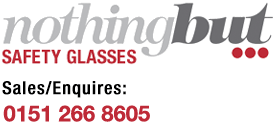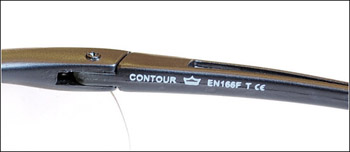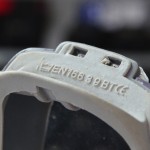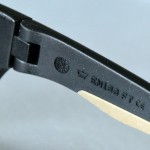What you’ll see on the frame
The frame will usually be marked on the inside the arm or somewhere along the frame. All safety frames must pass the European EN166 standard giving a degree of protection. There should also be the mandatory CE mark which indicates they comply with EU safety, health and environmental requirements.
Next will be a numbers and/or letters which indicate to what degree the frames passed the EN166 test within various categories. Below we’ll look at what these letters and numbers mean and give a couple of examples. The little Crown icon is simply the manufacturers seal.
You can view and print a concise guide to these standard by clicking here
The Numbers
The numbers will give you an idea of the protection you get from airborne risks like water or dust rather than fast moving projectiles.
3 – protect against liquid droplets and splashes. This is usually only found on goggles where a full seal is made around the eyes.
4 – all of the above and protection against large dust particle over 5 microns in size.
5 – all of the above and protection against dust and fine dust particles smaller that 5 microns.
8 – resistance to short circuit electric arc
9 – resistance to molten metal and hot solids
Advice: If you need to protect against water, dust or gas then you need to choose a pair of Safety Goggles. Safety glasses rarely can protect against any of the above risks and so as a general rule you wont see any of these numbers on safety glasses and only on safety goggles. An exception however is the Bolle Tracker.
The Letters
The letters are quite straightforward and used to describe the strength of the frame from an impact.
S – withstand impacts against small objects traveling up to 12 meters per second
F – withstand impacts against small objects traveling up to 45 meters per second
B – withstand impacts against small objects traveling up to 120 meters per second
A – withstand impacts against small objects traveling up to 190 meters per second
T – ability to maintain strength at high temperatures (i.e. working in warm climates or hot industrial areas)
Advice: You will rarely find glasses or goggles with “S” marked on them and frankly the protection they offer is minimal. You want to ensure you’re wearing glasses with at least an “F” frame and if you are doing high risk work with flying projectiles then move up to “B”. The marking “A” is rare for normal industrial use and often only found in the military. If you are planning to work in a hot factory or in warm climates then ideally you’ll also look for the “T” symbol.
Example 1: Bolle Pilot Goggle
As you can see from the image (click it to enlarge), the Grade says EN166 3 9 BT. This goggle therefore adheres to the minimum standards of EN 166. 3 means that you get protection from protect against liquid droplets and splashes and then 9 means that the frame will withstand impacts from molten metal and hot solids. Additionally it is “B” and “T” rated so can be used in warmer climates and hot industrial conditions to protect against small objects traveling up to 120 meters per second.
All in all this is a good goggle and could be used for angle grinding in a hot factory due to the “9” and “T” mark. It could also be used around contaminated or dirty water because of the “3” mark.
Example 2: Bolle Mamba Safety Glasses
In this image (click it to enlarge) the Mamba glasses have a rating of EN166 FT. These are only glasses so don’t give protection from liquid, dust, gas or molten metals so there are no numbers after the EN166. It does having have a mechanical strength and gets “F” for protection of impacts against small objects traveling up to 45 meters per second and then also the “T” rating which means it will still be strong when working in high temperatures.
In practice these glasses are quite advanced. They provide the usual protection in terms of strength you’d get from safety glasses (F Rating) but you get the added “T” rating which means they could be used abroad in hot climates or in a hot factory and still keep their strength.



